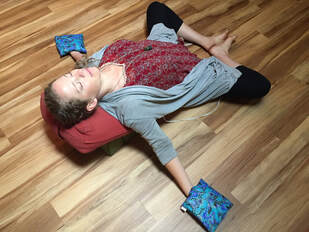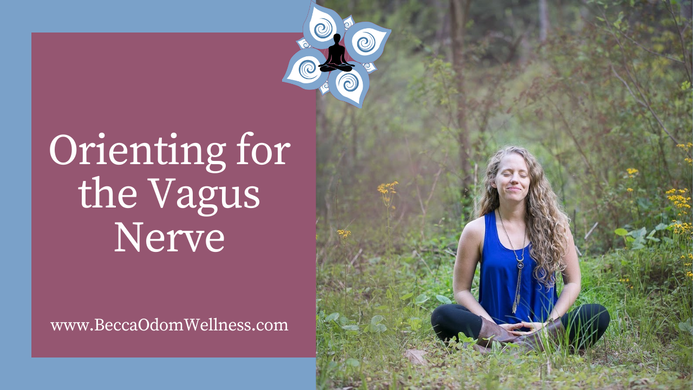 Orienting to the space we are in is an important tool to help stimulate our vagus nerve and calm the nervous system. Our vagus nerve is always tracking our environment to create what’s called “neuroception” which is our ability to detect safety in our environment. Intentionally turning our bodies and orienting to the space we are in can stimulate our vagus nerve, help us become more oriented into the present moment and help to build this neuroception and our vagal tone. Identifying exits and parameters of the room and confirming what is behind us can help us feel more grounded, safe and present. After orienting ourselves, we can begin to take deep belly breaths to continue this calming of the nervous system. Join me in this simple grounding and orienting practice to support the vagus nerve by clicking here to help feel safer in our bodies and our environment. For more free resources and weekly tips to build resilience, you can join my newsletter by clicking here. May we all love the life we live…
0 Comments
 We live in an overstimulating world and it can be a lot sometimes, especially as a Highly Sensitive Person (HSP). Finding ways to decompress and allow our nervous systems to “digest” is key to managing our stress and not burning out. Often we think that zoning out on our phones or binge watching a show is “rest” but that is still requiring our nervous system to digest even more sensory input. True rest and decompression requires us to decrease the sensory input so that our nervous system can truly heal. I like to consider the input vs output of sensory input in my day so I can better understand what I need for decompression time. Some examples of decompression:
There are so many ways we can allow our nervous system to digest the sensory input from the day. Finding which tool will work best for you and then scheduling that time is key. For folks with kids at home, it might be doing a short practice in the car before leaving work or before walking into the home. We encounter stress every day so practicing these tools every day to decrease the stress response and help us move into that “rest and digest mode” of the nervous system is important to prevent burnout. I hope you find these tips and tools supportive! For more free resources, you can join my newsletter by clicking here to receive more tools for increasing your resilience and managing stress. May we all love the live we live...  Stimulating the vagus nerve is key to helping to calm our nervous system and manage stress more effectively. The vagus nerve is our tenth cranial nerve, extending from its origin in the brainstem through the neck and the thorax down to the abdomen, connecting with major bodily organs. It carries an extensive range of signals from digestive system and organs to the brain and vice versa. The vagus nerve regulates body temperature, heart rate and functioning, impacts our inflammation within the body and helps the brain get signals when we are full and should stop eating. For folks with anxiety disorders, PTSD or autonomic disorders, a vagal nerve massage and vagal nerve stimulation may be helpful. Vagal nerve stimulation: A clinical treatment where a surgical device is implanted to help stimulate and regulate the vagus nerve. You can learn more about the research being done on it by going to clinicaltrials.gov Vagal nerve massages: This is a practice you can do at home to stimulate the vagus nerve, help calm the nervous system and build vagal tone. Essentially the vagus nerve is what helps us detect safety in our environment and with others. Improving our vagal tone is key to helping us improve our ability to create this sense of safety. For a full video of a vagal nerve massage, click here. There are a lot of nerve endings for the vagus nerve in the ear, which is where the practice begins. The concha is the inner part of the ear (like a conch shell) and the tragus is the flap of skin right in front of the ear. The main branch goes down behind the jaw bone and down along the large muscle in your neck, down to the throat.
This stimulation of the vagus nerve will help us build vagal tone, which is our ability to effectively respond (not over respond or under respond) to sensory input. Yoga, meditation and biofeedback are all ways to begin to build vagal tone. For more resources and videos for building resilience and healing, as well as learn about upcoming classes, you can join my newsletter by clicking here. May we all love the life we live... |
AuthorWrite something about yourself. No need to be fancy, just an overview. Archives
April 2024
Categories |


 RSS Feed
RSS Feed